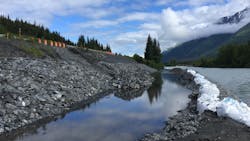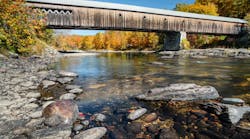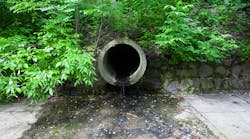Public and private owners responsible for the design and construction of infrastructure likely will encounter projects that enter a period of permit noncompliance. Irrespective of the factors responsible for permit noncompliance, owners need a general strategy to assist prime contractors as they restore stormwater permit compliance on projects gone astray.
During the construction of public and private infrastructure, prime contractors’ stormwater management programs exist to prevent or reduce the discharge of pollutants to waters of the United States.
Site-specific stormwater management is accomplished by a stormwater pollution prevention plan (SWPPP). A SWPPP is a site- and project-specific document that identifies potential sources of stormwater pollution at a construction site, describes the best management practices (BMPs) to reduce or eliminate pollutants in stormwater runoff, and identifies the procedures a permittee will implement to remain compliant with local requirements and a construction general permit.
A construction general permit authorizes pollution control and sets conditions of the discharge to Waters of the U.S. (WOTUS) parameters to ensure protection of water quality and human health. The permit describes control measures that must be used to control pollutants discharged from construction sites.
Types of Permit Non-Compliance
Specific stormwater permit noncompliance items generally can be divided into two categories: on-site BMP issues and SWPPP documentation issues. BMPs broadly include on-site erosion and sediment control measures, good housekeeping measures, and phased earth disturbance and stabilization.
Although BMP issues are considerably more conspicuous to project stakeholders, SWPPP documentation issues require more effort by the contractor and owner to alleviate than on-site issues. When instances of concurrent permit violations take place, it can be best to prioritize initial efforts toward on-site BMPs, as these issues pose the largest threat to water quality.
Common On-Site Issues
Upon discovery of permit noncompliance, the owner’s designated resident engineer (RE) or SWPPP inspector needs to identify the following: any project areas requiring supplemental or alternative BMPs; each erosion and sediment control BMP requiring maintenance or removal; any on-site good housekeeping issues that need to be addressed (i.e., project debris, track-out, fuel and maintenance areas, concrete washouts, etc.); and any disturbed areas requiring temporary or final stabilization.
Following identification of these on-site issues, the SWPPP inspector is recommended to work directly with the contractor’s superintendent and verify that trade workers have been trained to install and maintain the BMPs selected for the project.
Stormwater Documentation
To adequately address SWPPP documentation issues, the RE or SWPPP inspector needs to have a working knowledge of the local construction general permit; environmental related permits and documents; and project specifications dictating erosion, sediment, and pollution control.
Similar to the on-site assessment, the RE or SWPPP inspector needs to evaluate the contractor’s SWPPP for completeness and accuracy. As previously indicated, determining which SWPPP documentation processes employed by a contractor are noncompliant can be challenging, especially for large earthwork projects where several areas have active grading and stabilization activities.
Documentation noncompliance issues frequently relate to the following areas of focus: project site maps or SWPPP construction site inspection reports do not accurately identify or document installed BMPs; incorrect listing and identification of project discharge points; incorrect grading and stabilization entries; lack of modifications to project-specific authorizations for stormwater discharge; inconsistent stormwater training implementation or record keeping; or implementation of ground disturbing activities prior to permit coverage or without the proper delegations of signatory authority.
Contractor Questions
Although local agencies provide construction stormwater permitting guidance or recommended corrective actions for individual permit violations, this guidance does not extend to projects troubled with simultaneous violation categories. Additionally, each recommended corrective action or issue-specific guidance is presented independently, and the project as a whole is not considered.
Consequently, agency guidance does not encompass the worst-case scenario, which results in a couple critical unanswered questions: When the worst-case scenario transpires, what permitting elements should be focused on? What steps are necessary to alleviate all identified and unidentified noncompliance issues?
General Strategy to Restore Permit Compliance
This article’s field-demonstrated strategy can be applied to small, medium, and large-scale projects, though a customized approach with minor owner-conducted due diligence will be necessary.
The strategy to restore stormwater permit compliance is presented below as a series of five steps.
Step 1
Prioritize initial efforts toward on-site BMPS, as these issues pose the largest threat to water quality. The action items include performing an on-site assessment identifying permit discrepancies and then communicating findings of the assessment to the contractor.
Step 2
Coordinate with the superintendent and verify trade workers have been trained to install and maintain BMPs selected for the project.
Step 3
Perform a thorough review of the contractor’s SWPPP for completeness and accuracy. The RE should also evaluate the weekly or regular SWPPP documentation processes implemented by the contractor.
Step 4
Communicate key findings to the contractor: SWPPP documentation discrepancies identified by the RE and practical solutions to resolve those discrepancies.
Step 5
As a final form of permit compliance quality assurance, the last step requires the RE to monitor the contractor’s bolstered stormwater management effort. The contractor may require additional assistance with BMP selection and installation, or the contractor may need assistance regarding the correct development of erosion and sediment control maps. The RE or SWPPP inspector is recommended to assist as appropriate with any SWPPP modifications. Certain circumstances, however, may necessitate coordination with the designer of record or SWPPP preparer.
These steps provide a standard approach that public owners and private developers can implement to restore stormwater construction general permit compliance when their projects go awry. SW
Published in Stormwater magazine, August 2022.






